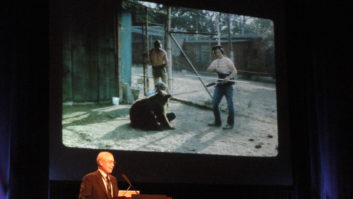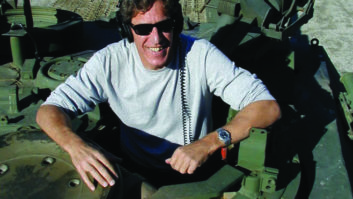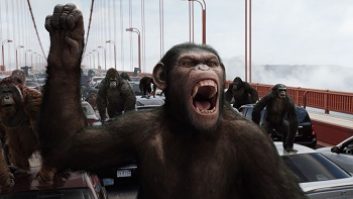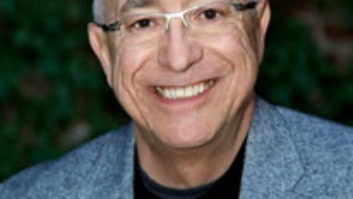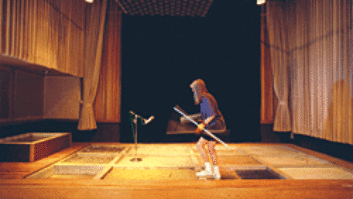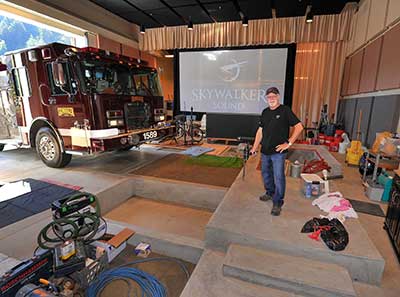
The stats would seem to lead to retirement from a long career in filmmaking: your IMDB listing has more than 450 features, and you’ve been at the top of your craft since the early 1980s, when you helped to virtually reinvent it. Such might be the case with many people behind the camera and in post-production, but not with Foley artist John Roesch. Last year he was offered the chance to help design and work on a new Foley stage at Lucasfilm Ltd.’s Skywalker Ranch, and he undertook that assignment after working for Warner Bros. for over 23 years. The stage went online in October.
Roesch started in Foley in the late 1970s, first at Gomillion Sound and then a stop at Warren Sound West before settling at Samuel Goldwyn Studios at their fabled Sawyer Sound facility right around its changeover to Warner Hollywood. He recalls that period at Goldwyn as “Camelot,” working directly with beloved engineer John Bonner, and with many of the top re-recording mixers who, because of the contract guarantees of the day, would often work as Foley mixers.
In these early days he worked on such films as The Black Stallion and Star Trek: The Motion Picture, and he credits his collaboration with sound supervisor Gordon Ecker on The Long Riders and especially The Ninth Configuration (aka Twinkle, Twinkle, “Killer” Kane) as turning points in his creative evolution. “Gordon was not only interested in sync, obviously, but much more so. How’s this person’s Foley sounding as a character,” Roesch says. “These were the marching orders from director William Peter Blatty, and Gordon worked hard with me to do that. I didn’t realize it at the time, but that was the genesis of much that I have learned and was a workshop.”
His next step was a nine-year run at Taj Soundworks, which became famous in the Los Angeles post-production community since its opening in early 1983 as the place to go to for Foley. The name was an acronym from the first names of its principals, mixer Tim Sadler, facility owner Allan Goodman, and Roesch. Another important part of the equation was chief engineer Ed Bannon.

Roesch credits Sadler (whom he had met at Warren Sound West) with “repurposing off-the-shelf multitrack recording studio technology in a way that had not been done in the film industry, which was lagging behind about 10 years. His music recording background gave him a good sense of how you could layer elements on a multitrack where, combined, they had a nice roundness to them. “What I’ve learned over the years is that it’s not what I bring to the table, but what everyone, collectively, brings,” he says. During much of the time at Taj, his Foley partner was Joan Rowe. Since then he’s worked with Ellen Heuer, Hilda Hodges, and, for the past 14 years, Alyson Dee Moore.
Taj used an Audio Kinetics Q.Lock synchronizer to lock the MCI 24-tracks with Betamax industrial video decks. (This was at a time when digital audio workstations were a distant dream, and all serious sound editing was done on 35mm mag against 35mm black and white dupes.) On occasion, Taj was also used for special ADR, such as the voices in Gremlins, many of which were recorded in sync against picture at half speed, doubling the pitch and speed in playback.
While Taj became famous (some industry vets might say infamous) at the time for its use of Monster Cable, Roesch notes that it was in fact replaced at Taj by cable made by Bruce Brisson of Music Interface Technologies. “I heard an A/B of his cable and normal cable, and, boy, it was the difference between talking with your hand over your mouth and taking it away.” Roesch believes that recording digital on Pro Tools HD partly removed the need for special cable, but he’s open to a demo at his new stage.
When he parted ways with Taj in 1992, Roesch went back to Warner Hollywood, where he stayed for eight years, before moving to the Warner Bros. Burbank lot since 2000. The genesis of this latest move started with informal talks with Josh Lowden and John Null, general manager and director of production, respectively, at Skywalker Sound, and then in 2014 they said that they were seriously thinking about building a new stage. Roesch talked to his family and the Skywalker staff and “all the answers came back ‘yes,’ and I was able to be involved in the design. It’s a culmination of all the years of experience, especially at Taj, which I designed with Tim Sadler and Ed Bannon.” During the building of the new room, Bannon has been consulting with Roesch and has been “a huge help.”

One important, shared design feature between the two facilities is a dirt pit being directly connected to earth, with no concrete foundation in the middle. “I believe in having a huge dirt pit that goes down to mother nature, which reduces pit ‘thumpf,’” Roesch says. “I don’t believe in smaller dedicated pits for sand and gravel, and would much rather sprinkle them on a larger dirt pit so I can naturally move to and from them as I see the character do on screen.” Adjacent to the 7-by-9-foot dirt pit are surfaces that make sense for transitions.
The water tank is also a bit of a lift from Taj, where there was not one small tank, but a way to make one tank bigger. “Here at the Ranch, because the physical space is bigger, we have two tanks and a ‘runway’ which we can fill up leading up to the smaller tank. Think of it as a ‘slip ’n slide’ that we can modify the depth to create various splash surfaces. In front is a bathtub-sized tank, adjacent to the main tank that holds over 300 gallons, perfect for ocean effects.”
Insofar as acoustics are concerned, Roesch is happy that the “‘resting state’ of the stage is very good. It has to have some sense of room, but not so much that it is obnoxious or ‘boingy.’ It has to feel pleasant. The attention to detail from an acoustic standpoint is crucial.” While Roesch still generally favors the Neumann KMR 81, the longtime Hollywood ADR/Foley standard microphone, he’s looking forward to experimenting with the “plethora of microphones that Skywalker has to see what makes the most sense. Because it’s so much of a clean slate, I’m open to anything.”
Roesch says that designing the stage, and the location of its pits and surfaces, from scratch gave him a “blank sheet of paper. I threw out ideas and Jim [Austin, Skywalker Sound engineering supervisor] gave me some alternative ideas which, combined, made the most sense.” Prop storage is always a crucial consideration on Foley stages, and in this room Roesch has his two U-Haul trucks full of props stored behind the stage, pulled out in restaurant carts as needed.
This is the fourth Foley stage at the Ranch, and occupies what was previously the Archive Building. The first was also very large (1,600 square feet vs. the new room’s 1,260; the largest Foley stage in North America is probably C5’s in New Jersey, which is 1,800 square feet), occupying in the Technical Building what is now known variously as Mix A or the Akira Kurosawa Stage. (The great Japanese director’s signature, made during the original construction, remains in the concrete foundation of the room.) When this room was repurposed, Foley was moved to the Carriage House, and then finally to a smaller area in the first floor of the Tech Building. This room is still in use with its longtime Foley artists Sean England, Dennie Thorpe and Jana Vance. Roesch doesn’t have a new Foley partner on the stage yet, but is working with mixer Scott Curtis.
The archive building was storage for “all things George,” and the specific area used by the Foley stage was where his cars were housed. As you can see by the photograph, the side door can be opened to allow not only cars to come in, or trucks carrying large props, but also Skywalker Ranch fire trucks, if needed.
Roesch, who is 61, says that he is “having too much fun to retire. Someone asked me, ‘Why did you do this?’ It’s almost as if we’re running a marathon, and you’re coming into the ‘finish chute’ with your running partner, where you go across the finish line. You can do one of two things: you can go across the finish line talking, or you can drop it into first gear and give it your all, huffing and puffing across the finish line, knowing that you really gave it your all. That is exactly what I’m doing here. This is the final chapter in my career and it’s reenergized me to be with all the wonderful people. I feel I’ll be good ’til I’m 70, to work on a new stage with all of these possibilities and capabilities. I’m grateful for the chance.”
